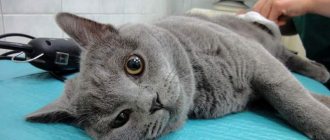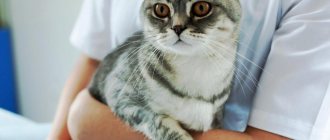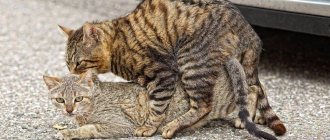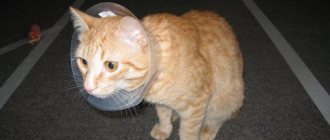Despite the fact that castration has long been a routine procedure, the success of cats’ recovery after it largely depends on proper care. Caring for a neutered animal should begin immediately after returning home from the veterinary clinic. Only following all the recommendations will alleviate the pet’s condition, speed up the rehabilitation period and prevent complications. What kind of care does a cat require after castration?
The likelihood of consequences occurring during surgery at home and in the clinic
Complications after castration in cats occur only if errors were made during the operation. When implementing the intervention at home, the risk of negative consequences is reduced, because the animal feels better in a familiar environment. At the same time, the cat does not have an extra reason for stress, which contributes to the rapid recovery of the body. At home, the animal recovers from anesthesia more easily.
Castration of a cat in a clinic may be accompanied by risks. In most cases, there are other animals in the room, which can cause concomitant diseases.
Possible negative consequences and complications occur both at home and in the clinic if the pet suffers from chronic pathologies.
How does puberty occur in kittens?
When kittens reach sexual maturity, they begin to look for a mate. This happens at the level of instincts. In males, maturation occurs at the age of 9-12 months, in females - at 5-6 months. In some cats, maturity may occur earlier or much later, depending on many factors (including the time of year the cat is born).
Signs of puberty in male kittens:
- the kitten begins to mark its territory;
- the kitten becomes restless, sometimes aggressive, meows a lot and loudly;
- If a kitten is allowed to walk on its own, it may not appear at home for several days or fight with neighbor cats.
Signs of puberty in female kittens:
- the pet leaves marks;
- becomes restless, as if she is constantly looking for something;
- the cat meows loudly;
- behavior becomes unpredictable;
- the cat raises its tail and rolls on the floor,
- A cat that is usually not interested in the street may try to run away in search of a partner.
Caring for your pet during the postoperative period
After castration of a cat, all measures must be taken to ensure complete rest for the animal. If the operation was performed in a clinic, the pet should be taken home in a special transportation. Carrying a cat in your arms is not recommended. In the first days you need to monitor the condition of the animal.
At home, you need to prepare a place in advance. It should be a flat but soft surface. It is better if the cat sits on a bedding on the floor. Otherwise, after the anesthesia wears off, the animal may fall and be injured.
Place a bowl of water next to the litter. On the first day after surgery, the pet may refuse to eat. This is normal, your appetite will gradually return. It is not recommended to give your cat large portions right away. You need to gradually switch to a standard amount of food. Nutrition after sterilization and castration should be balanced.
If the suture bleeds, you should consult a doctor as soon as possible.
The surgical site must be treated with antiseptic solutions, which will be prescribed by a specialist. A small amount of ichor in the first days is normal.
To prevent the seams from coming apart, you need to purchase a high collar that will prevent your pet from reaching the groin area.
Care and treatment of a cat's wound after castration
Castration, performed in a specialized veterinary clinic by an experienced doctor, is considered a relatively safe procedure for pets. Complications may arise in the postoperative period due to improper care of the injured area.
To eliminate the risks of infection and bleeding, the owner needs to regularly inspect the seam and treat the wound using alcohol-free antiseptics. To eliminate the risk of developing an inflammatory process, it is also recommended to lubricate the operated area with Levomekol ointment.
Treatment of the postoperative wound is carried out until it is completely healed and the sutures are removed. As a rule, cats recover quickly after castration and after 5-10 days the wound heals and the stitches are removed.
If during the rehabilitation period there are signs of complications - bleeding, suture dehiscence, inflammation in the wound area, etc., the owner needs to immediately show the pet to the veterinarian!
When can you remove the collar?
After surgery, a special collar is fixed on the animals’ necks to prevent cats from licking the wound, which can lead to infection and suture rupture. The required period of wearing the collar after castration is at least 5 days. Experts allow you to remove it for a short time, but only if the cat is under the watchful control of the owner.
Cat's diet after castration
After castration, the diet of a domestic cat changes significantly. You will have to remove a number of foods and regular food from your diet. If the pet is used to eating industrial compounds, the owner needs to buy special food for neutered cats.
Since a castrated cat is no longer interested in natural sexual processes, he compensates for sexual interest with increased nutrition, which often leads to obesity and a short life. To prevent the animal from rapidly gaining weight, the owner needs to carefully consider the diet and control the portions served without going overboard with the dosage.
Important rules:
1. The usual portion for a cat is reduced by 20%. Portions are calculated according to the age of the animal. 2. Salt and other types of spices are completely excluded from the diet (they increase the risk of developing urolithiasis). 3. Do not give cats food that is too hot or cold. Food should be warm. 4. Do not allow food to remain in the cat's bowl. After each feeding, the container must be cleared of food debris. 5. Adult cats should not be fed more than 2-3 times a day. 6. During the postoperative period, new food products should not be introduced into the animal’s diet. 7. It is unacceptable to overfeed your pet. 8. Try to feed your cat at the same time every day. 9. The animal should always have clean drinking water freely available.
What and when to feed
Castration of cats is carried out under anesthesia, so the animal should not be fed for the first 5-6 hours after the procedure, which can cause vomiting. After fully awakening, the cat may demonstrate its desire for a snack. In this case, you can give the animal some of its usual food or special food for neutered cats.
In the future, the pet’s diet must be strictly controlled. If the cat is accustomed to natural food, fish should be excluded from the daily menu, as well as foods rich in calcium, magnesium and phosphorus.
Diet of a neutered cat:
· lean meat (not fried) – chicken, rabbit, turkey, beef;
· meat by-products; · vegetables (make up 10-15% of the diet); · boiled porridges from different types of cereals; · eggs (whites); · low-fat fermented milk products. If a cat begins to rapidly gain weight after castration, you need to reduce portions and switch the animal to a dietary diet.
How many hours after can a cat drink?
In the first hours after the surgical procedure, cats should not be given water. 2-3 hours after the operation, when the effect of anesthesia subsides, the cat can be given a little water from a syringe. Upon returning home, it is important to provide the animal with free access to drinking water. You can’t restrict your operated pet’s drinking.
How to alleviate the condition of an animal
It is important to give your pet more to drink and not to forget about the painkillers prescribed by the veterinarian. Such medications will help the cat get rid of unpleasant symptoms that may be present in the first few days after surgery.
To alleviate the condition after castration, the following groups of drugs may be recommended:
- Antibiotics. Necessary to eliminate infection or if there is a high risk of complications after sterilization of a kitten (for example, swelling and other symptoms). The dose and drug are prescribed by the doctor, based on the age and condition of the animal’s body.
- Vitamins. Helps you recover faster. Often, the doctor prescribes special foods containing vitamins. In this case, the animal returns to normal in a short time.
- Hemostatic medications. Used only in rare cases. If the risk of bleeding is high, then medications that affect the level of platelet aggregation are prescribed.
During the recovery period, the animal may be lethargic, especially after anesthesia. At this time, it is better to leave your pet alone and let him sleep, periodically monitoring his condition.
How long does it take for the wound to heal before the cat can be bathed?
It is not recommended to wash your pet until the incision site has completely healed. Since the animal wearing the collar cannot lick itself, during this period hygiene procedures should be limited to wiping it with wet wipes and using dry shampoo.
When exactly the wound will heal and the cat can be bathed depends on many factors - age, body condition, presence or absence of infection, so it is definitely impossible to answer this question. This process usually takes about 1.5–2 weeks. Based on this, you can wash your pet for the first time after surgery no earlier than 10–14 days later.
Possible complications
Cat behavior and physiology change after castration because... The organ responsible for hormonal balance is removed. The animal rarely shows aggression. However, after anesthesia, unpleasant consequences often occur in the form of vomiting, diarrhea, and involuntary urination. Such complications often pass without a trace and are the body’s response to intervention.
The age for castration also plays a decisive role. The older the pet, the higher the risk of negative consequences. In rare cases, bleeding occurs. But this consequence is associated with errors during surgical intervention.
Sometimes the habit of marking territory may persist, but this complication occurs in isolated cases. This is due to incomplete removal of the gonads and castration at the age of 5-7 years.
Another consequence that may occur is kidney stones. The formation of stones is associated with a metabolic disorder in which uric acid accumulates. Fever may be present for some time after surgery. Most often it subsides already on the 2nd day. If the fever does not go away, this may indicate inflammation, which requires mandatory examination by a specialist and appropriate treatment.
Often, after removal of the gonads, a cat develops obesity. After the intervention, the animal’s appetite increases, the pet becomes not as active as before, which provokes excess weight gain. In this case, the owner must adjust the cat's diet.
All information posted on the site is provided in accordance with the User Agreement and is not a direct instruction to action. We strongly recommend that before using any product, you must obtain a face-to-face consultation at an accredited veterinary clinic.
What is the difference between sterilization and castration?
Among owners, the term "sterilization" is usually applied to cats, and "neuter" to male cats. From a medical point of view, these are two different procedures that have different effects on the animal’s body. But both operations are performed on both sexes.
Sterilization is a surgical procedure in which the fallopian tubes are ligated in cats, and the testes are ligated in male cats. As a result, animals can no longer reproduce, but all organs remain in place. Sex hormones continue to be produced in the pet’s body. This means that behavioral problems associated with finding a partner are not solved by sterilization.
Castration is an operation to remove the genitals. In cats, the ovaries and uterus are removed, in cats the testes are removed. In case of castration, the production of sex hormones stops. Pets do not feel attraction and become calmer. There are no problems that usually occur during the search for a partner.
To solve problems with marks and behavior characteristic of the heat period, castration is better suited.
Feeding a castrated cat natural food
So, successful castration of the cat is behind us, care after the operation is the next step for the animal’s quick recovery. If your furry friend is accustomed to natural food, you should not suddenly change your taste preferences. Continue to pamper your pet with the usual foods, only in smaller quantities and with some restrictions.
Useful natural for neutered pets:
- Fermented milk products with a small percentage of fat content.
- Boiled and raw vegetables (approximately 15% of the total diet). You can combine these products with meat dishes.
- Raw lean meat, previously frozen. This product can also be served lightly boiled.
- Raw quail eggs.
- Liver, kidney, hearts and other offal (boiled or raw, without spices and salt).
- Small portions of porridge made from buckwheat, rice and oatmeal.
- Chicken bouillon.
- Sometimes you can give fruit in small quantities.
Make sure your cat always has clean water in his bowl to drink. Rinse the bowl regularly to remove food debris. Do not overfeed and do not be lazy to cook separately for your four-legged friend. Proper care after sterilization is the key to a long and happy life for your furry family member!
More information about sterilization can be found here
Care before surgery
There is a set of established rules and recommendations for the care of animals undergoing surgery:
- absence of direct contraindications for castration of a cat;
- normal appetite;
- normal body temperature;
- no problems with stool;
- a deworming procedure and general treatment against parasites were carried out;
- good tests and vaccinations done on time.
If owners have any doubts about the health of their pet in the preoperative period, they should immediately inform the veterinarian. Adult cats over 5 years old are recommended to undergo general blood and urine tests first.
The effect of anesthesia on a cat's body
Anesthesia is the introduction of an animal’s body into artificial sleep using a drug. This occurs due to inhibition of the work of the cortical centers of the brain. Gentle drugs can reduce general or local sensitivity. Such drugs have a relatively gentle effect on the brain.
Anesthesia is an exposure to a toxin, and therefore has a destructive effect on cardiac structures and nerve fibers. In most cases, this causes hallucinations, visual and auditory disturbances, sleep disturbances and headache attacks. Mild side effects disappear 3-5 hours after using painkillers.
Operations are performed with caution in the presence of heart disease. Some drugs can affect the conduction system, which causes arrhythmia. In most cases, the effects disappear after a few days. In the presence of underlying chronic pathologies, the cat takes a long time to recover from anesthesia after castration.
How long does it take for cats to recover from anesthesia after surgery?
The time to recover from anesthesia depends on a number of factors:
- type of drug used;
- dosage of the drug and depth of sleep;
- body weight, age and some individual characteristics;
- state and type of nervous system.
To sterilize a cat, gentle means are most often used, since the operation does not affect deep internal tissues. With the use of modern drugs, recovery time is reduced to 2-3 hours, but uncharacteristic behavior can persist for 3 days. When using potent drugs, the pet can sleep for 8-20 hours.
Transportation home
After the operation, the cat will have to be picked up while still asleep, under anesthesia. Or gradually moving away from it. The animal must have a protective collar or blanket. For aggressive pets it is better to use the first option. You also need to trim your nails. This set of measures will protect you from scratches and bites. A collar and blanket are needed to prevent the cat from licking the seams and causing inflammation.
The cat should not be taken away immediately, but after 20-30 minutes to finally make sure that the bleeding has stopped. Postoperative pain relief must be administered before transportation. The animal must be transported in a special spacious carrier, in a position on its side. Your pet should breathe freely. The position on the side will allow vomit to pass freely if this happens: it will not enter the trachea and clog the airways. You need to get home as quickly as possible without your pet catching a cold, especially in winter if the cat is smooth-haired.
Vaccination for a cat
An animal that is not vaccinated in a timely manner runs the risk of catching an infectious disease while walking, and during a surgical operation the risk increases several times. At least 1 month must pass since the last vaccination, only then can the cat be castrated without fear of infection.
There are cases when, for one reason or another, animals that were not vaccinated on time are allowed to undergo surgery. In this case, the pet is injected with a serum that protects the cat from infections for 2 weeks. This approach increases the cost of the procedure and shifts responsibility for some postoperative complications to the owner.
Benefits of cat sterilization
Sterilization has economic, preventive and therapeutic purposes and is often associated with the fact that the cat owner often does not have the opportunity, and sometimes even the desire, to raise kittens from his cat.
The behavior of an unsterilized cat during heat (estrus) is accompanied by aggressiveness; the cat becomes restless, unkempt, constantly howls and screams, calling for the cat, and takes measures to run away from the house in search of the cat. And having run away from home, he mates with any stray cat he comes across, who often suffer from various infectious diseases.
After sterilization, your cat becomes more obedient, and sterilization usually does not have any effect on its temperament.
Cat owners should keep in mind that sterilization carried out at an early age will not only save your cat from numerous diseases of the uterus and ovaries, but will also save you from future inconveniences that owners of an unsterilized cat experience.
Summarize:
- a sterilized cat will be less distracted by its sexual instincts and will devote more time to you and your family members;
- a sterilized cat is less likely to wander and get injured while searching for its partner;
- has a lower risk of cancer and pyometra, diseases that most often affect unsterilized cats;
- Considering that during the period of heat, a cat can defecate in inappropriate places, thereby damaging carpets and furniture. With sterilization you will get rid of this;
- You will be freed from the financial and spiritual costs associated with treating a pregnant cat, as well as illnesses when feeding your kittens. All this costs a lot of money, caring for growing kittens due to the fact that you will have to monitor their feeding, vaccination, fight worms, and also deal with the issues of selling them in good hands.
The most popular and recommended cat food brands
Sterilization radically changes the life of a pet and its habits. If earlier your cat urgently demanded a walk and was looking for a cat, now he is only interested in food. A cat that eats excessively high-calorie foods will begin to gain weight, and this is already a bad sign for the animal. To keep his figure normal, choose the right food!
The range of cat products includes two main types of food: dry and wet. They differ in composition and cost. If the owner chooses the first option, it is necessary to provide the animal with constant access to drinking water.
Which food is better, dry or wet, is up to you to decide; there is no clear answer to this question. The main thing is to choose a fresh composition of proven quality with mandatory certification, giving preference to reliable brands. Experts do not recommend choosing budget food. Such savings can negatively affect the health of the animal.
Premium class food
Experienced breeders recommend giving preference to the following brands:
- Hills – a large assortment of therapeutic and prophylactic products that help prevent obesity in animals;
- Royal Canin - nutritional composition rich in vitamins;
- Purina PRO PLAN is a balanced food with pribiotics that improve intestinal function.
Preparing a cat for surgery
- A few days before surgery, the cat needs to be dewormed for helminthic infestation.
- Before sterilization, you must keep your cat on a 12-hour fasting diet.
- Your cat must be clinically healthy.
- A month before surgery, the cat should be vaccinated against feline infectious diseases common in the area. Since when you visit a veterinary clinic, where you usually go with sick animals, your immunity weakened by the operation, you can catch some kind of infection.











